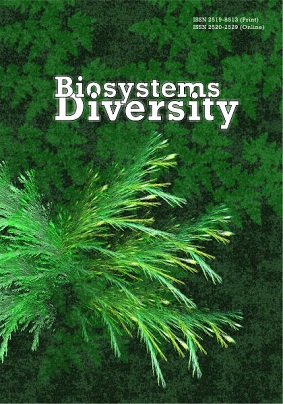Anthropogenic transformation of the flora of urban ecosystems of the Northern Pryazov territories
Anthropogenic transformation of the flora of urban ecosystems of the Northern Pryazov territories
Author(s): O. G. Bren, A. M. Solonenko, Y. I. Maltsev, S. Y. MaltsevaSubject(s): Energy and Environmental Studies, Environmental Geography, Human Ecology, Environmental interactions
Published by: Дніпропетровський національний університет імені Олеся Гончара
Keywords: urban flora; Nothern Pryazov territories; biodiversity; adventive fraction;
Summary/Abstract: The paper provides a thorough analysis of the current situation about biodiversity of model city in the Nothern Pryazov territories – Henichesk (Kherson region). The urban flora species composition of this city is represented at first time. There are 507 species, which belongs to two divisions, 61 families and 233 genera. Urban flora was analyzed in systematical, biomorphological and environmental aspects. The species richness of families of the studied urban flora is characterized by a predominance of families which include 1–2 species. The most part of urban flora species are herbaceous plants – 80.1% (406 species), including herbaceous monocarpics – 236 species and herbaceous policarpics – 170. It was found that terophytes have prevalence – 36.1% by the types of biological species in the urban flora of Henichesk, the second place takes hemicryptophytes – 31.9%. Other biological types are represented in a small quantity – 32%. An important characteristic of flora is species distribution for the main types of vegetation (rythmologic groups). The dominated status in the researched urban flora set the summer green plants – 430 species (84.8%). Analyzing the position of the aerial shoot for the leaves position we have differed rosette, semirosette and rosetteless plants. Species with rosetteless shoot are dominating. Rhizomeless species in the flora of Henichesk are dominating (51.1%) and species with caudex (23.6%), indicating the dominance of xerophytic habitats and increased soil density in cities. The largest environmental group is a group of moderate moisture, which consists of 349 species (68.8% of the total species number). There is predominance of heliophilous and shade-tolerant species, and mezotrophs. Adventive component of Henichesk flora has 217 species (159 genera and 52 families). The most part among them kenophytes, xenophytes, epecophytes. It was found that Henichesk have specific urban flora that combines elements of natural flora and typical urban components.
Journal: Biosystems Diversity
- Issue Year: 25/2017
- Issue No: 3
- Page Range: 222-227
- Page Count: 6
- Language: English

